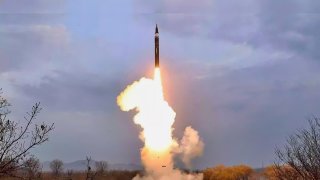Seoul: North Korea’s New Hypersonic Rocket is a “Clear Act of Provocation”
Last Monday, North Korea (DPRK) tested a new ballistic missile that could present a credible threat to U.S. military forces in the region and to American allies.
The North Korean military tested an intermediate-range hypersonic ballistic missile (IRBM) as part of Pyongyang’s determination to accelerate its nuclear and ballistic missile capabilities.
A New Hypersonic Ballistic Missile
In terms of its performance, the North Korean military claimed that the new ballistic missile flew around 935 miles (1,500 km) and at speeds of up to Mach 12 (approximately 9,200 miles per hour). Moreover, the North Korean military stated that the new munition reached an altitude of sixty-two miles (100 km) and then achieved a “second peak” at twenty-six miles (42.5 kilometers).
When it comes to missile flight, a “second peak” implies that the munition can change course midflight while it maintains altitude. Such dynamic flying means that the munition is much more dangerous and can adjust to conditions on the ground.
Pyongyang also claimed that the test was successful, and the new hypersonic ballistic missile hit its intended target on the east coast of the Korean Peninsula.
However, the South Korean military presented a different view of the missile’s performance. According to the South Korean military, the North Korean new ballistic missile flew approximately 685 miles (1,100 km) before crashing into the sea. Moreover, the South Koreans did not detect a “second peak” during the missile’s flight. However, South Korean officials maintained some reservations and said that they would conduct additional analysis in conjunction with the U.S. military.
Overall, Seoul labeled the missile launch as a “clear act of provocation” and strongly condemned it.
“We are aware of the (DPRK)’s ballistic missile launch and are consulting closely with the Republic of Korea (ROK) and Japan, as well as other regional allies and partners,” the U.S. Indo-Pacific Command (INDOPACOM) said in a press release.
Pyongyang decided to test its new ballistic missile while the outgoing U.S. Secretary of State Anthony Blinken was visiting South Korea for discussions with the country’s leaders. The ballistic missile launch was also the first since November.
“The United States condemns these actions and calls for the DPRK to refrain from further unlawful and destabilizing acts. We have assessed that this event does not pose an immediate threat to U.S. personnel, territory, or our allies. We will continue to monitor the situation. The U.S. commitments to the defense of the ROK and Japan remain ironclad,” INDOPACOM added.
Lately, North Korea has been barging into the international spotlight with its military antics.
A few months ago, the South Korean and Ukrainian intelligence services revealed that Pyongyang had sent Russia approximately 11,000 troops to fight against the Ukrainian military. The North Korean contingent has already suffered heavy casualties in the fighting against the Ukrainian forces inside the Kursk salient in Russia.
And now, the testing of this new hypersonic ballistic missile reminds Pyongyang’s neighbors, the United States, and the world that the North Korean regime remains as dangerous as ever.
Stavros Atlamazoglou is a seasoned defense journalist specializing in special operations and a Hellenic Army veteran (national service with the 575th Marine Battalion and Army HQ). He holds a BA from Johns Hopkins University and an MA from Johns Hopkins School of Advanced International Studies (SAIS). His work has been featured in Business Insider, Sandboxx, and SOFREP.
Image Credit: Shutterstock.

